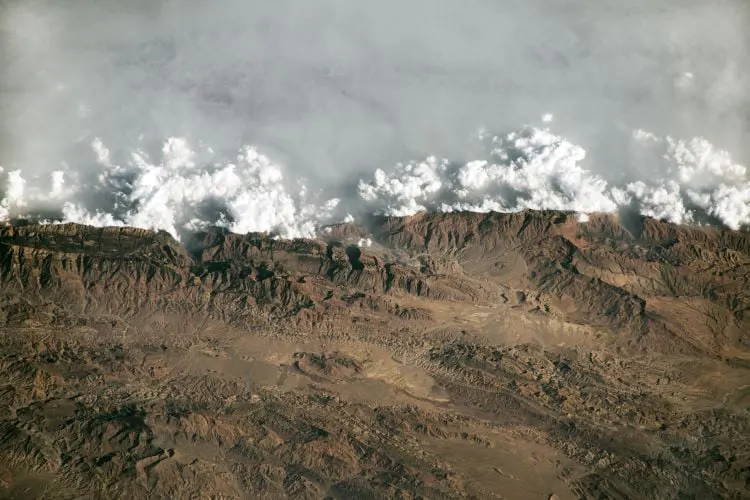In a breathtaking display of Earth’s natural beauty, an astronaut aboard the International Space Station (ISS) captured a remarkable image of the Sulaiman Mountains in Pakistan, showcasing a thick wall of haze and clouds being dramatically forced against the towering peaks. Although this awe-inspiring photograph was taken in December 2023, it was only recently featured as NASA’s Earth Observatory “Image of the Day” in April 2024, and has since captivated audiences around the world.
The Sulaiman Mountains: A Natural Divide
Natural boundary: The western plateaus of Pakistan are separated from the lush Indus River Valley to the east by rugged geological features like these mountains in the Sulaiman Range. Soaring about 9,800 feet (3,000 meters) towering above sea level these Airy summits act as watchdogs controlling the climatologically and ecological functions of the region.
This geographic S-shaped cut is where oversaturated ankle-winds from the nearby Indian Ocean smash into the rocky rubble of a behemoth range— the Sulaiman Mountains. One result, illustrated here, is a dramatic case of terrain-forced flow (characterized by the pools or streaks of clouds/haze unable to make it above and over those high mountains).
To continue learning about the incredible place we live here on Earth, use National Geographic subscriptions or Google Earth Pro to explore beyond our most beautiful locations.
The Captivating Image: A Closer Look
The image, taken by an astronaut aboard the ISS Expedition 70 mission, shows this distinctive combination of mountains appearing rugged and rough from a side-bound perspective casting its light fell unlike shadows on them. This image shows thick atmospheric haze and clouds spilling over high-elevation ridges near Dhana Sar, in a region where the prominent gash of a gorge cuts through the Sulaiman range. It provides a similar pinch of the atmosphere, to force itself through and funnels in both wild winds but also glourious cloud creeping which is as beautiful, scientifically enlightening.
The photo was snapped by a Nikon D5 digital camera with the help of a 460-millimeter lens, NASA’s Earth Observatory said in its description. The image is cropped and color-corrected to boost contrast, allowing a better depiction of the harsh backdrop underscored by this dramatic meteorology.
If you are a photography enthusiast, then be sure to check Nikon Cameras or Adobe Photoshop for capturing and editing magnificent landscapes that can compete with what is seen from space.
Terrain-Forced Flow: The Science Behind the Spectacle
What we are seeing in this image is an example of terrain-forced flow, a weather phenomenon that happens when the air column forces more moist layers to be pushed around and over mountains. Then there are the Sulaiman Mountains, where winds carry moisture from the Indian Ocean and it hits wall-like slopes that trap whatever haze or clouds happen along. Instead, they are deflected around the mountains usually forming an impenetrable “veil” or wall of mist to seaward.
This helps give the Himalayas its high-altitude climate but also contributes to regional processes—from weather events that upend lives in distant Bangladesh too patterns of plant growth.
For learners who want the basics of meteorology and atmospheric science, check out online courses from Coursera or Udemy.
The Importance of Astronaut Photography
This is where astronaut photography offers something truly special and invaluable — a perspective on Earth’s landscapes that we could only dream of from the ground. Photos such as this one of the Sulaiman Mountains not only serve to underscore some of Earth’s natural beauty but also offer a glimpse into how our planet’s intricate environmental system works.
They are contrasts, from polar to tropical glaciers and beyond large rivers that snake through jungles or create deltas in the sea — but each is a mystery as it appears 200 miles up.
These images continue to be archived monthly on NASA’s Earth Science and Remote Sensing Unit at the Johnson Space Center along with other space station imagery assets.
If you are a space fan and want to keep up with the latest in space exploration as well as Earth observation, check out subscriptions of NASA’s Earth Observatory or Sky & Telescope.
A Window into Earth’s Majesty
This gorgeous photo of the hyper-extended Sulaiman Mountains is a good way to sign off, as both an example and reminded that our planet,may be enigmatic in many respects but it just seems well! Between the light and shadow playing over rocky landslides to billowing clouds and smoke-in-its-manners, it is as much a science lesson hiding inside of an odd photograph, since it grounds note-to-ground reminder that Earth’s natural systems are sophisticated things.
As we explore and understand our planet from the ground, or space such images further enhance appreciation for the world around us and with it — why its beauty should be preserved – an understanding needed by many generations well into the future.
If you want to help out with conservation efforts, donate in the name of a loved one using World Wildlife Federation, World Land Trust or try purchasing products from brands like Patagonia(clothing/apparel) who are also passionate about preserving nature.


